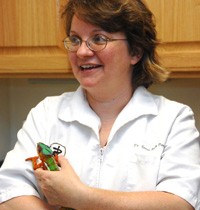Introduction
Alternative therapies can be very useful in treating rabbits for many acute and chronic conditions. The modalities work best when utilized in combination with traditional veterinary therapies. Although amazing results can be achieved, it is important that both the veterinarian and the animal’s caregiver discuss expectations for the therapies used. The most important goals would be to make the rabbit patient more comfortable, less anxious, and to have an improved quality of life.
Careful consideration of training and qualifications should be made when choosing veterinarians who use alternative therapies in their practice. As with other alternative modalities, some complementary treatments discussed in this article also require specific knowledge about rabbits; for example, an acupuncturist should be familiar with rabbit physiology.
This article discusses the use of microcurrent electrical therapy, cranial electrotherapy stimulation, cold laser therapy, and acupuncture, and the way they are used in rabbits for pain management, musculoskelatal issues like arthritis, and wound healing.
Microcurrent Electrical Therapy and Cranial Electrotherapy Stimulation (Alpha-Stim®)
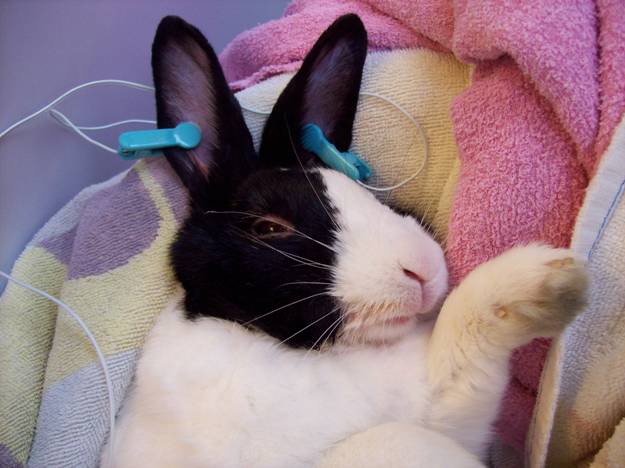
Microcurrent electrical therapy (MET) and cranial electrotherapy stimulation (CES), both generally known as Alpha-Stim®, are FDA-authorized prescription medical devices for treatment of pain, depression, and insomnia in humans. Both MET and CES have also been found to be useful in treating animals for pain and for stimulating wound healing.
MET promotes healing, sterilizes wounds, and modulates pain by initiating and sustaining biochemical and electrical reactions that work with the body’s electromagnetic fields. CES works to normalize the overall electrical firing of the brain’s hypothalamus to bring it back into homeostasis (internal equilibrium, or balance). This is referred to as the alpha state, which is similar to that produced by meditation.
At the primary author’s veterinary practice, MET and CES are used alone and in combination on a regular basis for all species: as an adjunct therapy for surgical pain, to help extensive wounds heal faster, for stress and anxiety-related disorders (e.g., over-grooming, separation anxiety), as well as for lameness, arthritis, and other pain-associated problems. The electrical current stimulates healing, helps eliminate infection, decreases the amount of anesthetic needed for surgical procedures, and helps to eliminate or diminish anxiety and pain.
The primary author has used MET and CES on many rabbits with great success, for arthritis, large traumatic wounds, chronic gastrointestinal hypomotility (slowdown), and head tilt. The therapy is also very beneficial for rabbits with anxiety and stress-related issues. Even in cases where the primary problem may not be correctable, head tilt for example, the therapy may help to restore musculoskeletal function that has been affected and eases the stress associated with the condition.
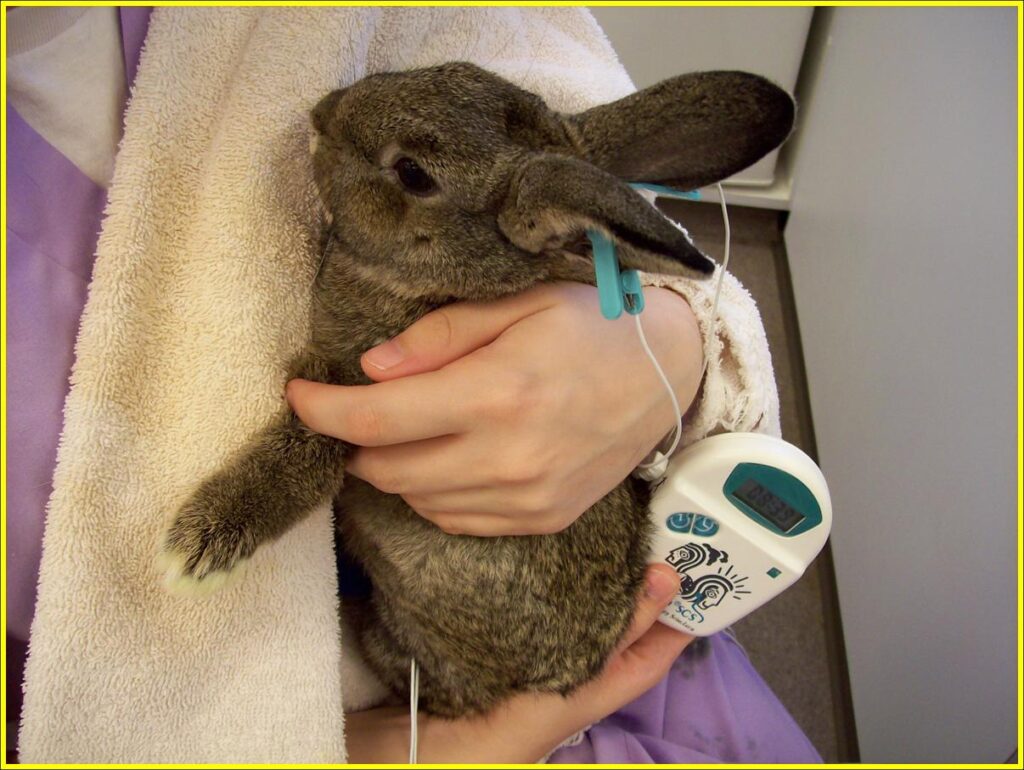
Alpha-Stim® is a non-invasive and drug-free therapy, and since the electrical stimulus is in the low microamperes, even animals as sensitive as rabbits do not feel pain or discomfort from the therapy. Within five minutes they adjust to the application and within ten minutes they become more relaxed.
In the primary author’s experience, MET and CES are effective adjuncts to the standard care provided to patients. When used in conjunction with other medical therapies, the two modalities have certainly helped rabbit patients become more comfortable and heal faster.
Cold Laser Therapy
Cold laser therapy is utilized in human physical therapy and rehabilitation and is also a useful tool for treating rabbits. The word “laser” is an acronym for “light amplification by stimulated emission of radiation.” The definition of laser includes mention of a device with an output that is in the visible region of the electromagnetic spectrum, which includes the entire range of radiation. Cold laser therapy incorporates a low-level radiation output, produced as a concise, targeted transmission that allows for minimal reflection and scattering while maximizing energy absorption at a specific depth. The energy is not the same as from the surgery laser, which cuts and burns; thus the name “cold” laser.
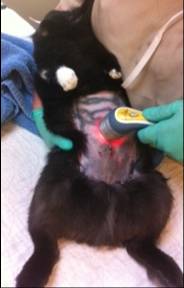
By using what is known as photobiostimulation, the energy (in the form of photons) from the laser is transmitted to the cells of injured tissue. By increasing cellular activity [photons stimulate mitochondria to accelerate the production of ATP (adenosine triphosphate)], the energy promotes healing. Local blood circulation is also stimulated, providing necessary nutrients to and bolstering the immune system in the affected area. Other physiological effects of laser therapy include the stimulation of fibroblast and collagen production (necessary for generating new connective tissue for wound healing), production of endorphins (natural pain killers), acceleration of the inflammatory process needed for healing, and increased angiogenesis (the formation of new blood vessels) and lymphatic drainage.
This therapy is non-invasive and easy for veterinarians to perform. There are relatively few contraindications: the eyes of the therapist and those of the patient require protection from the laser light, and laser therapy should not be used near or on the eye (to prevent retinal damage), on cancerous lesions, over areas of hemorrhage, and over endocrine glands – these are areas where cellular activity should not be stimulated.
Cold laser therapy helps reduce pain and inflammation, and it speeds the healing of injured and inflamed tissues. Frequency of treatment depends upon the condition being treated, as well as whether the issue is acute or chronic in nature. The effect of cold laser therapy is cumulative, with each treatment building upon the last. A rabbit with lumbosacral degenerative joint disease (discopondylosis), for example, might receive treatments as follows: two per week for one to two weeks, then one per week for several weeks, followed by several monthly treatments, and then only once every three to four months or as needed to keep the rabbit comfortable. Every patient and every case is different, and just like with people, overuse of muscles and joints or a newer acute injury might require a temporary increase in frequency. For wound healing, however, the frequency would be determined by healing response because each wound is different. Generally, wounds require two to three cold laser treatments per week for several weeks.
Cold laser therapy is indicated for many health issues in rabbits. At the primary author’s veterinary practice, the therapy has been used with significant success, treating rabbits with arthritis, discospondylosis, skin and ear issues, and cellulitis. Cold laser therapy has also been used both for post-surgical care and for wound healing.
Acupuncture
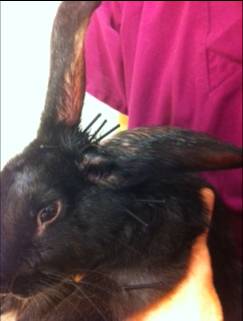
Acupuncture is a modality that helps with so many issues in both human and animal medicine. It has been an especially great adjunct to Western medicine at the primary author’s animal clinic in helping with pain, anxiety, and stress-associated problems in rabbits, as well as wound healing and gastrointestinal hypomotility and stasis (shutdown). The physiological effects of acupuncture (how the body responds) are created through a series of interactions among the nervous system, endocrine system, and the immune system. Acupuncture helps to open the flow of energy along the body’s natural meridians to decrease pain as well as to increase the pain threshold. By restoring normal energy flow, the organs are able to work more effectively, allowing the rabbit’s body to function better as a whole.
Rabbits tend to respond quickly to acupuncture and tolerate needling sessions well, though they are more sensitive to acupuncture at peripheral acupoints (the points along the meridians where the needles are placed), such as on the feet and legs. Traditional acupuncture is designed to treat the entire patient, rather than symptoms only. Therefore, each time the primary author sees a rabbit at the exotic care center, an individualized treatment plan is developed. Because most patients have a combination of problems, usually the most significant or acute issues are treated first, so the choice of acupoints may change as the more acute problems are minimized or as new issues arise. The primary author often uses herbal therapy to complement the acupuncture treatment, making changes in both as necessary to provide the best support for the rabbit.
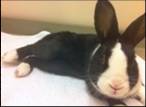
There are many success stories about the use of acupuncture for rabbits. As an example, an eight-year-old Dutch rabbit with a paralyzed left leg and severe arthritic changes in her lumbosacral spine was urinating on herself and exhibiting signs of pain, lethargy, and depression. She could move on her own, but only by pulling herself forward with her front legs; her rear legs dragged behind her.
The onset of her condition was quite sudden: two weeks earlier, the Dutch bunny was quivering and posturing differently with her back legs. At that time, cold laser therapy and MET/CES were administered. She also had pain in the lumbosacral area. Mild elevation of liver enzymes made the use of meloxicam more dangerous, so she was started on buprenorphine and tramadol.
Two weeks later, the Dutch rabbit presented with the “crabbing” motion, using her front legs only to move forward. Before making the final decision for euthanasia, the Dutch was offered acupuncture along with continued pain medication. Her initial response to the treatment was mostly in her affect: she appeared more comfortable (i.e., less pain) and less depressed and was eating better almost immediately. After the second treatment, she was using her right rear leg and hopping about. Her left rear limb showed improvement as well: both deep pain and voluntary movement were noted. In other words, her response to a toe pinch indicated improving neurological function of the limb (in paralysis, such response would be absent). As of eighteen months from the date of this article, the Dutch bunny’s quality of life remained significantly improved. She was able to hop with both rear legs and use her left rear leg to clean her ear. Though she still had some residual urinary issues, the Dutch rabbit was doing very well.
I wish to extend my thanks to Dr. Susan Brown for her review of the article and to Dr. Stephanie Crispin and Gary McConville for their suggestions.
Resources
- Midwest Microcurrent: www.midwestmicrocurrent.com
- Chi Institute: www.tcvm.com
- Vectra Genisys Laser: www.shor-line.com
Further Reading
- The Importance of Pain Management in Rabbits.
- Rabbit Welfare Association: Pain Management in Rabbits
- Pain Control in Pet Rabbits by Dr Susan Brown DVM.
- Wound Care in Rabbits (pdf) Friends of Rabbits Newsletter.
©Copyright Teresa Bradley Bays, DVM, CVA, DABVP (ECM), CVMMP, CTPEP. All Rights Reserved. Republished with the permission of the author.
